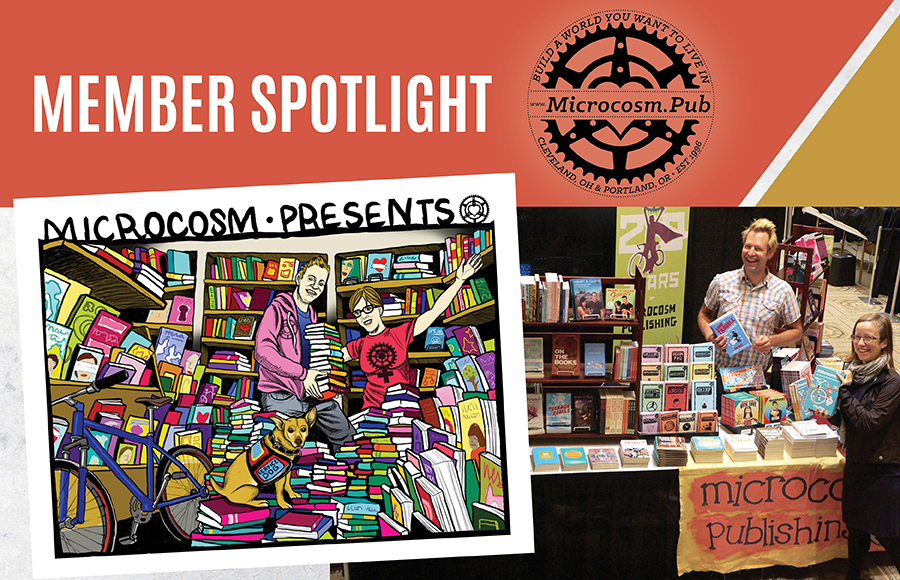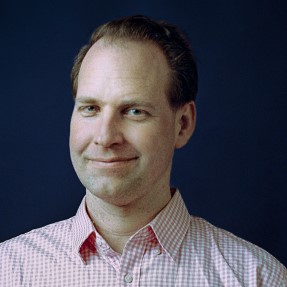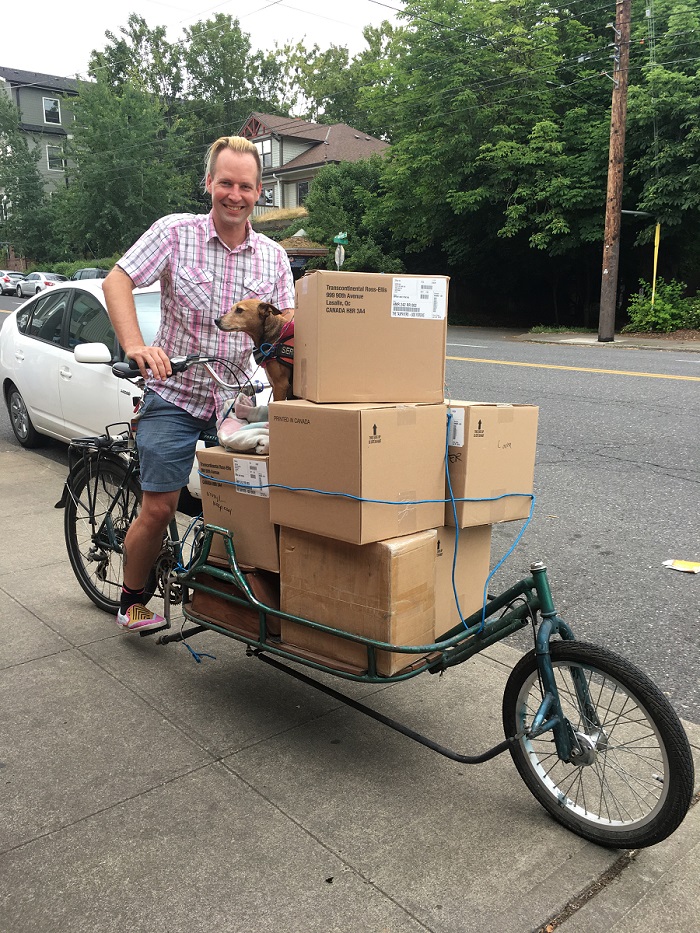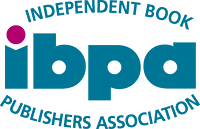 |
| Joe Biel and partner Elly Blue in real life, and their illustrated versions! |
How Microcosm Publishing became a Publishers Weekly's #1 Fast Growing Publisher by Charting Its Own Course For any publisher still hanging on to the notion that one’s books need to be distributed in major bookstores or be an Amazon bestseller in order to achieve sales success, take note of Microcosm Publishing who proudly does none of the above. And yet, Microcosm is one of today’s fastest growing publishers, named by Publishers Weekly as their number one fastest-growing publisher in 2022, and number three on the list in 2023. In fact, publisher and founder Joe Biel is well known for their anti-Amazon, pro-indie stance. So, how did they build Microcosm into one of the most fascinating yet successful indie publishers today, having sold millions of books? We’ll find out when Joe takes the stage this April as a panelist in the “Rise & Disrupt” keynote presentation at IBPA’s Publishing University. In advance of their Publishing University appearance, we connected with Joe to learn a little bit about how Microcosm is disrupting the traditional notions of publishing success by charting its own course.
 |
| Joe Biel |
Hi Joe, let’s start by saying how excited we are that you’ll be one of our “industry disruptors“ who is headlining the keynote presentation at IBPA Publishing University. We’re sure every single person in the audience is just dying to know how you do it without Amazon. But first, can you give us some context on what it means to be a Publishers Weekly #1 Fast-Growing Publisher? How many books did you print in 2023, and what has your year-over-year revenue been like? Wow, thank you. I love that you are interested in the numbers because so much of publishing is so hung up on the words! We printed 517,279 copies of 127 titles in 2023 and are planning 550,000 books coming into our warehouse, including 42 new titles for 2024! The trick in publishing is the stability and longevity of the backlist—the books that are over a year old. Our bestselling 2023 titles didn’t come out in 2023 or 2022. We plan our books so that what we publish in 2017 or even 2002 is still selling more in 2023 than they did during their year of publication. We keep finding more independent retailers who will shelve and love them. We grew 207 percent in 2020, a further 106 percent in 2021, another 21 percent in 2022 and we feel like this is a comfortable size, at least for now, since we have quintupled our staff and sales since 2018. Endless sales growth isn’t and shouldn’t be Microcosm’s goal—saving lives needs to be. Growth is apparently a side effect of that mission.
 |
| Microcosm's store in Portland, OR |
Tell us about Microcosm Publishing’s origin story. When did you found the press and why? What was your journey like, arriving to where you are today? I was a teenage autistic runaway in Cleveland who wasn’t assigned a single book to read during high school. I watched as my entire block got laid off from their factory jobs in the '80s. Any innocuous small talk question that you ask me will provoke an intense story. Through my interest in D&D, I read fantasy books in the '80s. My favorite was Curse of the Azure Bonds, about a woman who was controlled by a series of tattoos placed upon her body by her masters and forced to wear chain mail that exposed her heart—the only way to kill her. Naturally, she makes friends and together they destroy each of the monsters controlling her. As a fan of the Ramones, I shoplifted Jim Bessman’s book about the band in 1993 from a chain store and it forever changed my life. The book showed me what reading could do—take something that was interesting and make it more so. I sought to do the same thing as a mechanism to create resources to change readers’ lives and the world around them. We had a punk club that I hung out at on West 44th and Lorain, and apparently one drunken night I told some of the older kids that I was going to start the punk rock version of publishing. I started getting my things together in 1996 and I think they laughed it off at the time but 15 years later on tour in Los Angeles, I ran into one of them who proclaimed “You actually did it!”. I had no memory of what he was talking about. What types of books does Microcosm publish? I really want to manifest the grit and desperation that I feel on the inside. Many of the people that I grew up with didn’t make it and that informed my approach both to tone and subject matter of our books. So whether we are publishing gardening, craft, self-help, coloring books, nature, science fiction, sociology, queer smut, herbalism, history, or music, I want the overriding vibe to be that the reader is empowered. Periodically I worry that you can’t see our roots, but when I express this concern, people laugh. Is there is a theme or a mission to your publishing program? When we consider a new title, we ask “How does this equip the reader to change their life and the world around them? Does it cut backwards or punch down at all? Is it actually helping the reader?” One key to your success, and you’ve been quoted a few times for this phrase, is “the underground is bigger than the mainstream.” Can you explain what this means and your personal experience with this, especially in the sense that you’ve built a thriving sales and distribution network while avoiding the mainstream? A friend wrote a somewhat satirical treatise wherein he studies the mainstream the way that the mainstream always tries to study subcultures. I thought it was funny at first but now I think he is right. The mainstream is just one myopic blip that ignores things they cannot understand until they find a way to coop them. It’s the independent publishers and stores that are growing the market. We saw this again in the DOJ vs. Penguin Random House trial, when it was revealed that the only way that Simon & Schuster or Penguin Random House could grow their market share was through the distribution of independent presses. NPR did great reporting on how indie bookstores were also growing. And in 2016, my statement became literal: independent publishers comprised 54 percent of the market, and have continued to grow. Yet, who controls the power structures and why?
 |
| The team on a tour in 2009. |
A distributor is focused on their 10 biggest accounts, who can set their own terms and may or may not be a great fit for each publisher. The methods of consolidation are like trickle down economics: they never favor the people who don’t already control the power. You might get some crumbs, but it’s never going to tip the scales so you have the power when you are under someone else’s boot. One of the best parts of starting young and with no experience is that I am simply more stubborn and didn’t know what I don’t know or how difficult something will be. So I do it anyway. In the beginning, it was the independent stores that were receptive to me marching in the door with boxes of books and writing up invoices. During a conference panel in 2004, a publisher disparagingly told me that we were foolish for not putting barcodes on our books and selling into Barnes & Noble. Afterwards, young woman in the audience cried and begged me not to do this. We’ve now tried it both ways and in many ways, she was right. Twenty years later, we sell more to three independent stores that we have strong relationships with, than the entirety of Barnes & Noble. Why focus on 10 fickle accounts when we could focus on 14,000 cool stores that know we have their backs? You have your own distribution, two warehouses, and a bookstore in Portland. Tell us more about that, and why building your own distribution made sense for you. Early on, Microcosm was rejected by Small Press Distribution, so I kept the letter stating that there was no market for our books. That was the most motivating day of my career, next to when a Canadian distributor told me that we were too small to self-distribute. When we landed a national publicity spot in 2002, we signed with our first trade distributor. They asked for our customer list, assuming that they would handle all of our business operations. I said “No, we can continue handling those accounts. I assume that you have your own.” Sixteen years later, it had become repeatedly clear that we could handle these aspects better than anyone could for us. The day after her job interview in 2015, one of our salespeople said “We could do a better job in-house than our distributor does.” I was skeptical, and figured that if we worked really hard we could match their results, but it bore out. We set a new mandate in 2018: we would focus on independent retailers, stop supplying Amazon entirely, and put little to no effort into the 10 biggest accounts. We grew 156 percent in 2019 doing it ourselves through focusing on small stores. We add 150+ new stores each month, thousands per year. We dig deep to find new places to sell books and, as such, reach people that don’t think of themselves as readers or feel welcome in bookstores. When we left our fifth distributor, they claimed that they had done as well as they could considering how marginal our books are. The following four years were our fastest growth period in our history, 81 percent of which was from books published prior to terminating that agreement. We simply know best how to reach our ideal customer. In many ways, I’ve kept my early life experiences central in how I think about who our ideal reader is. Then we purchased our third warehouse in 2023! We should be remiss if we didn’t mention that Microcosm quite literally, published the book on this topic! How to Resist Amazon and Why has sold more than 48,000 copies. The book clearly strikes a chord with many publishers. Tell us a little about this book and why it’s so successful. Obviously, you can’t find this book on Amazon! So how did people discover this book and turned it into a bestseller? Ha! I thought you were going to plug A People’s Guide to Publishing, which is my book about how to recreate Microcosm’s success for your own press. But yes, Danny’s book was a lifeboat for many who felt strangled by Amazon’s hold on retail. Our editor, Lydia, followed Danny on social media and said “Hey, I think this could be really cool!” Within 24 hours, we’d inked a deal and five years later, it’s clear that no other publisher would touch this. I think that’s the same reason that the book is successful. People want to know alternatives and to feel empowered in agency for their own lives. Our field sales reps did a great job of showing this book to independent stores and it received many counter placements and impulse sales. The New Yorker did a story about the book and the New York Times asked Amazon why they had neglected to list it. The results were hilarious and awkward. In 2023, this turned into Microcosm becoming the distributor for Bookshop.org when they published the new Lydia Davis book, Our Strangers, because she didn’t want it sold on Amazon.
 |
| An avid cyclist, Joe (with mascot Ruby) has a special bicycle designed for deliveries! |
Another factor in your company’s success is your focus and investment in improving business operations. You even developed a proprietary software WorkingLit that automates many functions. Briefly, can you share with IBPA ‘s members what they should know about WorkingLit and how it can help small publishers? I think this is really the headline. For many presses, this stuff is an afterthought but it is more important than any book that you publish. In 2001, we had someone working in our production department who said “Hey, you could create a database to automate most of these processes.” I said “Sure, if you want to!” and the rest is history. Within five years it was the key to our success. WorkingLit manages all of our title data, sales, inventory, invoicing, accounting, shipping, when a title is due for reprinting, website, data exports, taxes, performance analytics, product management, and organization. It’s magical that we get a daily report of who we owe how much money to and when, which warehouse needs to ship which orders in which sequence, what books are going to need to reprint in the next 90 days based on their actual sales history and how long the printer takes, and which stores are due to make new orders. The magic of a system like this is that it was built by publishers for publishers, so we have to make sure that each tool actually works and each time when we say “Hey, I thought of another thing that we could automate!” behold, it becomes so! We have so many plans to expand this in the next few years as a sales and marketing tool so that others can recreate our successes! IBPA: Finally congratulations Joe, on receiving PubWest's Innovator Award last week in Arizona for “reimagining what publishing can or should be”! Microcosm is doing great stuff and we can; wait to hear more from you this April. Thank you Joe!
At IBPA Publishing Conference this April 25-27, 2024, Joe Biel will join as esteemed panel including Oriana Leckert, Kickstarter; Dhonielle Clayton, Cake Creative; and moderator Brooke Warner, She Write Press to explore current innovations and disruptions in indie publishing. Check out their “Rise & Disrupt” panel in the agenda and register to attend IBPA Publishing University 2024 in Denver.
Share your unique publishing stories with the IBPA community! Send to adeline@ibpa-online.org. For more details about the types of stories we're seeking, click here. Though launching a new book isn’t the focus of our Spotlights articles, IBPA is happy to share that exciting news on social media. Please contact ashley@ibpa-online.org with the launch date, your book cover, your book title, your book's genre, a link to where readers can learn more about your book, and your Instagram handle. For good news in general about your publishing company (your book received a wonderful editorial review, you have an upcoming speaking engagement, etc.), use the hashtag #IBPAmemberGoodNews on Twitter and IBPA will amplify your good news! Whether you have news or not, all of us at IBPA are cheering you on!
 About the Independent Book Publishers Association (IBPA) About the Independent Book Publishers Association (IBPA)
Founded in 1983 to support independent publishers nationwide, the Independent Book Publishers Association (IBPA) leads and serves the independent publishing community through advocacy, education, and tools for success. With over 4,000 members, IBPA is the largest publishing association in the U.S. Its vision is a world where every independent publisher has the access, knowledge, and tools needed to professionally engage in all aspects of an inclusive publishing industry. For more information, visit ibpa-online.org. |




 About the Independent Book Publishers Association (IBPA)
About the Independent Book Publishers Association (IBPA)




